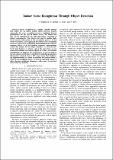| dc.contributor.author | Espinace, P. | |
| dc.contributor.author | Soto, A. | |
| dc.contributor.author | Kollar, Thomas Fleming | |
| dc.contributor.author | Roy, Nicholas | |
| dc.date.accessioned | 2010-10-05T19:19:47Z | |
| dc.date.available | 2010-10-05T19:19:47Z | |
| dc.date.issued | 2010-05 | |
| dc.identifier.isbn | 978-1-4244-5038-1 | |
| dc.identifier.issn | 1050-4729 | |
| dc.identifier.other | INSPEC Accession Number: 11431390 | |
| dc.identifier.uri | http://hdl.handle.net/1721.1/58874 | |
| dc.description.abstract | Scene recognition is a highly valuable perceptual ability for an indoor mobile robot, however, current approaches for scene recognition present a significant drop in performance for the case of indoor scenes. We believe that this can be explained by the high appearance variability of indoor environments. This stresses the need to include high-level semantic information in the recognition process. In this work we propose a new approach for indoor scene recognition based on a generative probabilistic hierarchical model that uses common objects as an intermediate semantic representation. Under this model, we use object classifiers to associate low-level visual features to objects, and at the same time, we use contextual relations to associate objects to scenes. As a further contribution, we improve the performance of current state-of-the-art category-level object classifiers by including geometrical information obtained from a 3D range sensor that facilitates the implementation of a focus of attention mechanism within a Monte Carlo sampling scheme. We test our approach using real data, showing significant advantages with respect to previous state-of-the-art methods. | en_US |
| dc.description.sponsorship | Fondo Nacional de Desarrollo Científico y Tecnológico (Chile) (FONDECYT) (grant 1095140) | en_US |
| dc.language.iso | en_US | |
| dc.publisher | Institute of Electrical and Electronics Engineers | en_US |
| dc.relation.isversionof | http://dx.doi.org/10.1109/ROBOT.2010.5509682 | en_US |
| dc.rights | Attribution-Noncommercial-Share Alike 3.0 Unported | en_US |
| dc.rights.uri | http://creativecommons.org/licenses/by-nc-sa/3.0/ | en_US |
| dc.source | MIT web domain | en_US |
| dc.title | Indoor Scene Recognition Through Object Detection | en_US |
| dc.type | Article | en_US |
| dc.identifier.citation | Espinace, P. et al. “Indoor scene recognition through object detection.” Robotics and Automation (ICRA), 2010 IEEE International Conference on. 2010. 1406-1413. © Copyright 2010 IEEE | en_US |
| dc.contributor.department | Massachusetts Institute of Technology. Computer Science and Artificial Intelligence Laboratory | en_US |
| dc.contributor.department | Massachusetts Institute of Technology. Department of Aeronautics and Astronautics | en_US |
| dc.contributor.department | Massachusetts Institute of Technology. Department of Electrical Engineering and Computer Science | en_US |
| dc.contributor.approver | Roy, Nicholas | |
| dc.contributor.mitauthor | Kollar, Thomas Fleming | |
| dc.contributor.mitauthor | Roy, Nicholas | |
| dc.relation.journal | Proceedings of the IEEE International Conference on Intelligent Robotics and Automation, 2010 | en_US |
| dc.eprint.version | Author's final manuscript | |
| dc.type.uri | http://purl.org/eprint/type/ConferencePaper | en_US |
| eprint.status | http://purl.org/eprint/status/PeerReviewed | en_US |
| dspace.orderedauthors | Espinace, P; Kollar, T; Soto, A; Roy, N | en |
| dc.identifier.orcid | https://orcid.org/0000-0002-8293-0492 | |
| mit.license | OPEN_ACCESS_POLICY | en_US |
| mit.metadata.status | Complete | |
